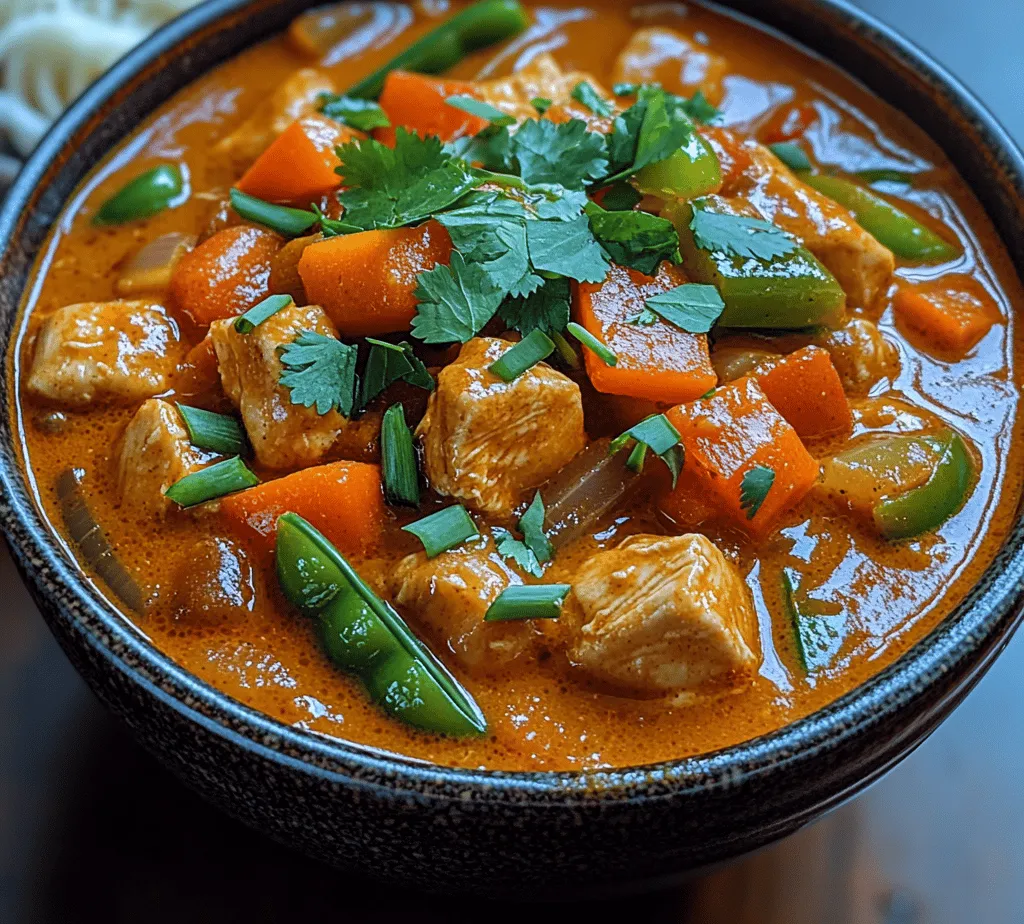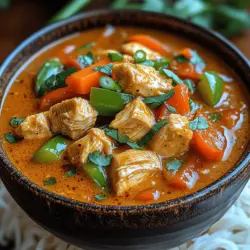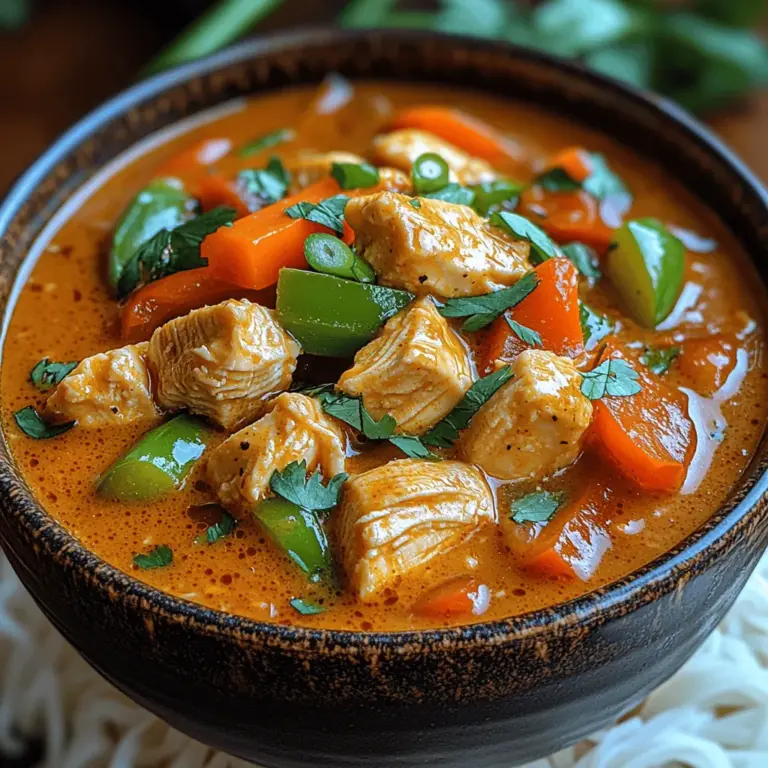Explore the vibrant flavors of Southeast Asia with this delectable Thai Chicken Curry Soup. This dish is a delightful blend of aromatic spices, tender chicken, and fresh vegetables, making it a comforting meal that warms the soul. Whether you’re looking for a quick weeknight dinner or a special dish to impress your guests, this recipe is versatile and easy to prepare. In this article, we will delve into the ingredients, preparation steps, and the cultural significance of this beloved Thai dish, giving you a comprehensive guide to crafting your own bowl of goodness.
The Allure of Thai Cuisine
A Brief Overview of Thai Flavors
Thai cuisine is renowned for its bold flavors and fragrant aromas, which come from a harmonious blend of fresh ingredients and spices. Key to this culinary tradition is the balance between four essential tastes: sweet, sour, salty, and spicy. This delicate equilibrium creates dishes that are not only satisfying but also complex, engaging the palate in a delightful dance of flavors.
A typical Thai dish may include ingredients such as lemongrass, galangal, kaffir lime leaves, and Thai basil, which are used to infuse aromas and flavors that are uniquely Thai. For instance, the sweet notes often come from palm sugar, the sourness from lime juice or tamarind, salty flavors from fish sauce, and the spiciness from fresh chilies or curry pastes. Each ingredient plays a vital role in achieving the perfect flavor balance, and this is especially true for Thai Chicken Curry Soup.
Popular Thai Dishes and Their Origins
Thai cuisine is a rich tapestry of regional influences and traditional cooking techniques. Some iconic dishes include Pad Thai, Tom Yum Goong (spicy shrimp soup), and Massaman curry, each with its unique history and flavor profile. These dishes reflect the country’s multicultural heritage, influenced by neighboring countries like China, India, and Malaysia, leading to an intriguing blend of culinary traditions.
Thai Chicken Curry Soup, while not as globally recognized as some of its counterparts, holds a cherished place in Thai households. It combines the rich flavors of curry with the comforting essence of soup, making it a popular choice during family gatherings and festive occasions. This soup not only showcases the hallmark flavors of Thai cooking but also highlights the country’s emphasis on fresh, high-quality ingredients.
Understanding the Ingredients
Fresh Ingredients for Authentic Flavor
The key to authentic Thai Chicken Curry Soup lies in the freshness of its ingredients. Using fresh herbs and spices enhances the overall flavor and aroma, elevating the dish to new heights. Here’s a closer look at the essential components of this flavorful soup:
– Chicken: Boneless, skinless chicken thighs are preferred for their rich flavor and tender texture. They hold up well in soups, absorbing the spices beautifully.
– Coconut Milk: A staple in Thai cooking, coconut milk adds creaminess and a subtle sweetness that balances the spiciness of the curry.
– Red Curry Paste: This is a blend of various spices and herbs, including dried red chilies, garlic, lemongrass, and galangal, providing depth and complexity to the soup.
– Fresh Vegetables: Common additions include bell peppers, carrots, and snap peas, which contribute to the dish’s visual appeal and nutritional value.
– Aromatics: Onions, garlic, and ginger are essential for building the flavor base. They are sautéed at the beginning of the cooking process to release their natural oils and flavors.
Focusing on these fresh ingredients ensures that your Thai Chicken Curry Soup is not only delicious but also captures the essence of authentic Thai cuisine.
The Role of Coconut Milk in Thai Cuisine
Coconut milk is a fundamental ingredient in many Thai dishes, known for its rich, creamy texture and subtly sweet flavor. It is derived from the grated meat of mature coconuts and is often used to balance spicy elements in dishes. Besides enhancing flavor, coconut milk offers nutritional benefits, being a source of healthy fats, vitamins, and minerals.
In Thai Chicken Curry Soup, coconut milk plays a crucial role in creating a luscious broth that envelopes the chicken and vegetables. The creaminess of the coconut milk complements the aromatic spices, resulting in a soup that is both comforting and indulgent.
Chicken Thighs vs. Other Cuts of Chicken
When it comes to choosing the right cut of chicken for your Thai Chicken Curry Soup, boneless, skinless chicken thighs are highly recommended. They are known for their rich flavor, tender texture, and ability to remain juicy even after cooking. Unlike chicken breasts, which can dry out, thighs absorb the flavors of the soup and contribute to a hearty, satisfying dish.
For those who prefer alternative protein options, boneless chicken breasts can be used, although they may require careful cooking to avoid dryness. Additionally, for a vegetarian or vegan version, tofu or chickpeas can substitute chicken, allowing for a deliciously plant-based adaptation of this beloved recipe.
Step-by-Step Preparation of Thai Chicken Curry Soup
Sautéing Aromatics for Maximum Flavor
The first step in crafting your Thai Chicken Curry Soup is to sauté the aromatics. Aromatics are the foundation of flavor in many dishes, and in this recipe, they include onions, garlic, and ginger. Begin by heating a tablespoon of oil in a large pot over medium heat. Once the oil is hot, add finely chopped onions and sauté until they become translucent, typically around 3-5 minutes.
Next, add minced garlic and ginger to the pot, stirring continuously to prevent them from burning. The moment the garlic and ginger hit the hot oil, they will release their fragrant aromas, setting the stage for the depth of flavor that will follow. Sautéing these aromatics properly ensures that their essential oils are released, providing a robust base for the soup.
Browning the Chicken for Depth of Flavor
Once the aromatics have softened and become fragrant, it’s time to add the chicken. Before adding it to the pot, season the chicken thighs with salt and pepper. This simple step enhances the overall flavor of the meat. Add the chicken to the pot and allow it to brown on all sides. This process, known as the Maillard reaction, is critical for developing rich, savory flavors.
Ensure that the chicken is not overcrowded in the pot, as this can cause it to steam rather than brown. Depending on the size of your pot, you may need to do this in batches. Aim for a golden-brown color on each piece, which will add complexity to the soup. Once browned, remove the chicken from the pot and set it aside.
Incorporating the Red Curry Paste
After browning the chicken and removing it from the pot, it’s time to build on the flavor foundation by adding red curry paste. This vibrant paste is the heart of Thai Chicken Curry Soup, providing the signature heat and aromatic quality that characterizes the dish.
Add a couple of tablespoons of red curry paste to the pot, using the residual oil and juices from the chicken and aromatics to help dissolve the paste. Stir it vigorously to release its full flavor, allowing it to cook for about a minute until it becomes fragrant. This step is crucial, as it activates the spices and herbs within the paste, infusing the entire dish with rich, aromatic notes.
—
With these steps, you are well on your way to creating a delicious Thai Chicken Curry Soup that captures the essence of Thai cuisine. The combination of sautéed aromatics, browned chicken, and fragrant curry paste lays a robust foundation for the rest of the soup. Stay tuned for the next part, where we will explore the remaining ingredients and the final steps to complete this comforting dish.

Tips on Adjusting the Spice Level to Taste
When it comes to Thai Chicken Curry Soup, achieving the right spice level is essential for balancing the dish’s rich flavors. To adjust the heat to your preference, consider the following tips:
1. Start Small: If you’re new to spicy foods, start with a small amount of curry paste. You can always add more as you cook, but it’s much harder to dilute spice once it’s in the soup.
2. Use Fresh Ingredients: Fresh chilies can be added for a more intense heat. Varieties like Thai bird chilies are commonly used in Thai cuisine and can be added whole or sliced into the soup during cooking.
3. Temperature Control: Cooking the soup at a lower temperature after adding the curry paste allows the flavors to meld without intensifying the heat too quickly.
4. Dairy as a Buffer: If your soup becomes too spicy, consider adding a bit more coconut milk or even a touch of yogurt at the end to help mellow the heat.
5. Acidic Balance: Adding lime juice not only enhances flavor but can also help counterbalance the heat. Taste your soup before serving, and adjust accordingly.
Creating the Base: Coconut Milk and Chicken Broth
The base of your Thai Chicken Curry Soup is integral to achieving the desired texture and flavor. The harmonious blend of coconut milk and chicken broth creates a creamy yet satisfying consistency.
1. Balance is Key: Use a ratio of about 1 can of coconut milk to 2 cups of chicken broth. This balance provides a rich and creamy soup without it being overwhelmingly thick.
2. Creamy Yet Light: For a lighter soup, you can replace half of the coconut milk with additional chicken broth. This adjustment allows the soup to maintain a creamy texture while making it less heavy.
3. Simmering Effect: Allow the soup to simmer gently after combining the coconut milk and broth. This slow cooking helps the flavors develop without curdling the coconut milk.
Building Flavor with Fish Sauce and Brown Sugar
Umami is a key component in many Asian dishes, and Thai Chicken Curry Soup is no exception. The combination of fish sauce and brown sugar brings depth and balance to the soup.
1. Umami Explained: Fish sauce is packed with umami, which adds a savory depth to the soup. Start with a tablespoon and adjust according to your taste preference, as it can be quite potent.
2. Balancing Act: Brown sugar not only provides sweetness but also helps balance the savory and spicy notes of the soup. It’s this contrast that makes Thai cuisine so unique. Add about 1-2 teaspoons, tasting as you go, to achieve the right balance.
Adding Vegetables for Color and Nutrition
Incorporating a variety of vegetables into your Thai Chicken Curry Soup not only enhances its visual appeal but also boosts its nutritional profile.
1. Nutritional Benefits: Vegetables like bell peppers, carrots, and snap peas are not only colorful but rich in vitamins and minerals. Bell peppers provide vitamin C, while carrots offer beta-carotene, promoting eye health.
2. Cooking Time Tips: To maintain the texture and flavor of the vegetables, add them to the soup based on their cooking time. For instance, denser vegetables like carrots should go in earlier, while quick-cooking vegetables like snap peas can be added just a few minutes before serving to retain their crunch.
The Finishing Touch: Lime Juice
In Thai cooking, acidity plays a crucial role in balancing flavors. Lime juice is the finishing touch that elevates the overall taste of your soup.
1. Significance of Acidity: Acidity brightens the flavors of the soup and cuts through the richness of the coconut milk. It is a vital component in achieving that signature Thai flavor profile.
2. Adding Lime Juice: Squeeze in the juice of one or two limes just before serving. This not only enhances the flavor but also adds a refreshing element that contrasts beautifully with the spices.
Serving Suggestions for Thai Chicken Curry Soup
How you serve your Thai Chicken Curry Soup can enhance the overall dining experience. Here are some optimal pairings and garnishing tips.
Optimal Pairings: Rice vs. Rice Noodles
When it comes to serving, you may wonder whether to pair your soup with rice or rice noodles. Both have their pros and cons:
1. Rice: Serving the soup over jasmine rice adds a hearty element and helps soak up the delicious broth. This pairing provides a comforting, filling meal.
2. Rice Noodles: Alternatively, rice noodles add a delightful textural contrast. They absorb the flavors of the soup beautifully and create a lighter dish. Choose thin rice vermicelli or thicker rice noodles based on your preference.
Garnishing for Visual Appeal and Flavor Enhancement
Garnishes are not just for decoration; they play an essential role in enhancing the flavor and visual appeal of Thai Chicken Curry Soup.
1. Importance of Garnishes: In Thai cuisine, garnishes often include fresh herbs and crunchy elements that elevate the dish. Fresh cilantro, Thai basil, or green onions can add brightness and freshness.
2. Alternative Garnishes: Consider toppings such as sliced red chilies for heat, toasted coconut for crunch, or even a sprinkle of crushed peanuts for added texture.
Nutritional Information and Serving Size
Understanding the nutritional content of your Thai Chicken Curry Soup helps you make informed decisions about portion sizes and dietary needs.
Breakdown of Nutritional Content
A typical serving of Thai Chicken Curry Soup contains approximately:
– Calories: 350-450 calories
– Protein: 25-30 grams
– Fats: 20-25 grams
– Carbohydrates: 30-35 grams
The key ingredients, such as coconut milk and chicken, contribute to a balanced meal rich in protein and healthy fats, making it a nutritious option.
Serving Size Recommendations
For those mindful of portion sizes, consider the following:
1. Standard Serving: A standard serving is about 1.5 to 2 cups of soup, which suits most dietary needs.
2. Meal Prep and Storage: If meal prepping, store the soup in airtight containers in the refrigerator for up to 3 days. Reheat gently on the stove, adding a splash of coconut milk or broth to restore creaminess if needed.
Conclusion: Enjoying Your Thai Chicken Curry Soup
Thai Chicken Curry Soup is not just a meal; it’s an experience that transports you to the bustling streets of Thailand. With its rich blend of flavors and comforting warmth, this recipe is sure to become a family favorite. As you savor each spoonful, you will appreciate not only the delicious taste but also the culture and tradition that inspired this dish. Embrace the art of Thai cooking in your kitchen and enjoy the joy of sharing this delightful soup with loved ones. Whether paired with rice or noodles, garnished with fresh herbs, or adjusted to your spice preference, this soup is a versatile, nourishing option for any occasion. Enjoy the journey of flavors and the warmth of this comforting dish.


